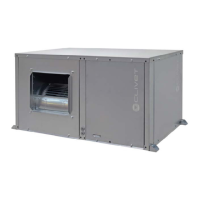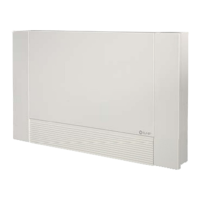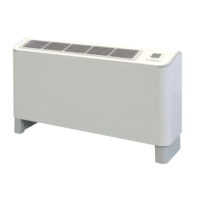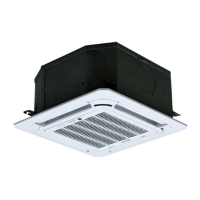60
EVH-X SPACE 2.1 - 12.1
M0SM10N17-03
General
In this section the most common situations are
signalled. As these cannot be controlled by the
manufacturer these could be a source of risk
situations for people or things.
Danger zone
This is an area in which only an authorised
operator may work.
The danger zone is the area inside the unit which
is accessible only with the deliberate removal of
protections or parts thereof.
Handling
The handling operations, if implemented without all
of the protection necessary and without due
caution, may cause the fall or the tipping of the
unit with the consequent damage, even serious, to
persons, things or the unit itself.
Handle the unit following the instructions provided
in the present manual regarding the packaging and
in compliance with the local regulations in force.
Should the gas refrigerant leak please refer to the
refrigerant "Safety sheet".
Installation
An incorrect installation of the unit could cause
water leaks, condensate accumulation, leaking of
the refrigerant, electric shock, bad functioning or
damage to the unit itself.
Check that the installation has been implemented
by qualified technical personnel only and that the
instructions contained in the present manual and
the local regulations in force have been adhered to.
The installation of the unit in a place where even
infrequent leaks of inflammable gas and the
accumulation of this gas in the area surrounding
the area occur could cause explosions or fires.
Carefully check the positioning of the unit.
The installation of the unit in a place unsuited to
support its weight and/or guarantee adequate
anchorage may cause the fall or the tipping of the
unit with the consequent damage to things, people
or the unit itself.
Carefully check the positioning and the anchoring
of the unit.
Easy access to the unit by children, unauthorised
persons or animals may be the source of
accidents, some serious.
Install the unit in areas which are only accessible
to authorised person and/or provide protection
against intrusion into the danger zone.
General risks
Smell of burning, smoke or other signals of serious
anomalies may indicate a situation which could
cause damage to people, things or the unit itself.
Electrically isolate the unit (yellow-red isolator).
Contact the authorised service centre to identify
and resolve the problem at the source of the
anomaly.
Accidental contact with exchange batteries,
compressors, air delivery tubes or other
components may cause injuries and/or burns.
Always wear suitable clothing including protective
gloves to work inside the danger zone.
Maintenance and repair operations carried out by
non-qualified personnel may cause damge to
persons, things or the unit itself.
Always contact the qualified assistance centre.
Failing to close the unit panels or failure to check
the correct tightening of all of the panelling fixing
screws may cause damage to persons, things or
the unit itself.
Periodically check that all of the panels are
correctly closed and fixed.
If there is a fire the temperature of the refrigerant
could reach values that increase the pressure to
beyond the safety valve with the consequent
possible projection of the refrigerant itself or
explosion of the circuit parts that remain isolated
by the closure of the tap.
Do not remain in the vicinity of the safety valve
and never leave the refrigerating system taps
closed.
Electric parts
An incomplete attachment line to the electric
network or with incorrectly sized cables and/or
unsuitable protective devices can cause electric
shocks, intoxication, damage to the unit or fires.
Carry out all of the work on the electric system
referring to the electric layout and the present
manual ensuring the use of a system thereto
dedicated.
An incorrect fixing of the electric components cover
may favour the entry of dust, water etc inside and
may consequently can electric shocks, damage to
the unit or fires.
Always fix the unit cover properly.
When the metallic mass of the unit is under voltage
and is not correctly connected to the earthing
system it may be as source of electric shock and
electrocution.
Always pay particular attention to the
implementation of the earthing system connections.
13 RESIDUAL RISKS

